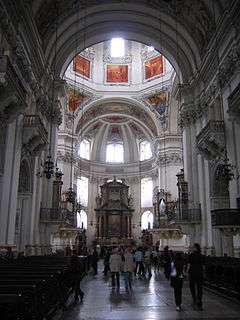Mass in C major, K. 259 "Organ solo"
| Missa brevis in C major | |
|---|---|
| "Organ Solo" | |
| Mass by W. A. Mozart | |
 Salzburg Cathedral may have been the first performance venue of the mass. | |
| Key | C major |
| Catalogue | K. 259 |
| Composed | 1776: Salzburg |
| Movements | 6 |
| Vocal | SATB choir and soloists |
| Instrumental |
|
The Missa brevis No. 8 in C major, K. 259, is a mass composed by Wolfgang Amadeus Mozart in 1776.[1] It is scored for SATB soloists, SATB choir, violin I and II, 2 oboes, 2 clarini (high trumpets), 3 trombones colla parte, timpani and basso continuo.
Although classed as a missa brevis (brief mass), the inclusion of trumpets in the scoring makes it a missa brevis et solemnis.[1][2] The mass derives its nickname Orgelmesse or Orgelsolomesse (Organ Solo Mass) from the obbligato organ solo entry of the Benedictus.[1][3] This is one of three masses Mozart composed in November and December 1776, all set in C major, including the Credo Mass (K. 257) and the Piccolominimesse (K. 258).[4]
The work consists of six movements. Performances require approximately 10–15 minutes.
- Kyrie Andante, C major, common time
- Gloria Allegro, C major, 3/4
- Credo Allegro, C major, common time
- Sanctus Adagio maestoso, C major, 3/4
- "Pleni sunt coeli et terra" Allegro, C major, cut common time
- Benedictus Allegro vivace, G major, 3/4
- "Hosanna in excelsis" Allegro, C major, 3/4
- Agnus Dei Adagio, C major, common time
- "Dona nobis pacem" Allegro, C major, 3/4
References
- 1 2 3 Sadie, Stanley (2006). Mozart: The Early Years 1756–1781.
- ↑ Eisen, Cliff; Keefe, Simon, eds. (2006). The Cambridge Mozart Encyclopedia. p. 276.
- ↑ Kennedy, Michael; Bourne, Joyce, eds. (2004). The Concise Oxford Dictionary of Music. p. 535.
- ↑ Einstein, Alfred (1945). Mozart: His Character, His Work. p. 338.
External links
- Missa in C K. 259: Score in the Neue Mozart-Ausgabe
- Free scores of Missa brevis in C Major (KV 259) 'Organ solo' in the Choral Public Domain Library (ChoralWiki)
- Missa brevis in C major, K.259: Scores at the International Music Score Library Project (IMSLP)
